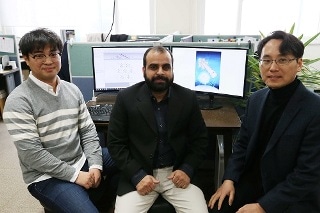Feb 25 2019
A research group from KAIST described a new non-linear device with the founding property originating from perovskite nanowires.
 From left: Juho Lee, Dr Muhammad Ejaz Khan, and Professor Yong-Hoon Kim. (Image credit: KAIST)
From left: Juho Lee, Dr Muhammad Ejaz Khan, and Professor Yong-Hoon Kim. (Image credit: KAIST)
They demonstrated that hybrid perovskite-derived, inorganic-framework nanowires can attain semi-metallicity, and projected negative differential resistance (NDR) devices with outstanding NDR characteristics, which are the result of a novel quantum-hybridization NDR mechanism, meaning the potential of perovskite nanowires to be achieved in next-generation electronic devices.
The exceptional optoelectronic properties, as well as the low cost and simplistic synthesis processes of organic-inorganic hybrid halide perovskites, have enabled them to recently evolve as promising candidates for photonic applications. Important advancements have been already made for devices such as light-emitting diodes, solar cells, lasers, and photodetectors.
However, study on electronic devices based on hybrid halide perovskites has not been vigorously carried out when compared to their photonic device counterparts.
Professor Yong-Hoon Kim from the School of Electrical Engineering and his colleagues closely observed low-dimensional organic-inorganic halide perovskite materials, which have improved quantum confinement effects, and specifically concentrated on the recently synthesized trimethylsulfonium (TMS) lead triiodide (CH3)3SPbI3.
With the help of supercomputer simulations, the team initially demonstrated that stripping the (CH3)3S or TMS organic ligands from the TMS PbI3 perovskite nanowires leads to semi-metallic PbI3 columns, which denies the standard assumption of the insulating or semiconducting characteristics of the inorganic perovskite framework.
The team employed the semi-metallic PbI3 inorganic framework as the electrode and designed a tunneling junction device from perovskite nanowires. They identified that they show exceptional nonlinear negative differential resistance (NDR) behavior. The NDR property is an important factor to achieve the next-generation, multi-valued, and ultra-low-power non-linear devices. Moreover, the team identified that this NDR arises from a novel mechanism involving the quantum-mechanical hybridization between electrode states and channel.
This research demonstrates the potential of quantum mechanics-based computer simulations to lead developments in advanced nanomaterials and nanodevices. In particular, this research proposes a new direction in the development of a quantum mechanical tunneling device, which was the topic for which the Nobel Laureate in Physics in 1973 was awarded to Dr Leo Esaki.
Professor Yong-Hoon Kim, School of Electrical Engineering, KAIST.
This study, headed by Dr Muhammad Ejaz Khan and PhD candidate Juho Lee, was published online in Advanced Functional Materials on January 7th, 2019.